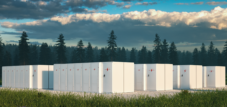Published on: May 21, 2025 / update from: May 21, 2025 - Author: Konrad Wolfenstein

Power control costs in comparison: is nuclear power really more expensive than renewable energies? - Image: Xpert.digital
Photovoltaic: Why open space systems are the future of energy
Comparison of electricity costs: Photovoltaics clearly beat nuclear energy
Photovoltaic open-air facilities are actually among the most cost-effective forms of electricity in Germany, while nuclear energy is significantly more expensive. This is confirmed by current studies.
Current electricity costs at an overview
According to current analyzes of the Fraunhofer Institute for Solar Energy Systems (ISE), the electricity costs are formed as follows:
- Photovoltaic open-air facilities: 4.1 to 6.9 cents/kWh
- Wind energy on land: 4.3 to 9.2 cents/kWh
- Lignite power plants: 15.1 to 25.7 cents/kWh
- Motor coal power plants: 17.3 to 29.3 cents/kWh
- Gas power plants (GUD): 10.9 to 18.1 cents/kWh
- Nuclear power plants (new building): 13.6 to 49.0 cents/kWh
Renewable energies, especially photovoltaics and wind power, are today the most cost -effective electricity generation technologies in Germany.
Suitable for:
Why is nuclear power more expensive than shown often?
1. High investment and construction costs
The investment costs for nuclear power plants make up about 56-72% of the total costs. These costs have risen continuously in recent years, while the costs of renewable energies have dropped greatly. In France, EU internal market commissioner Thierry Breton estimated that investments of 50 billion euros were required for the existing nuclear power plants by 2030 alone, and even 500 billion euros for the construction of new reactors.
2. Long construction times and financing costs
Core power plants typically have very long construction times, often more than 10 years. These long construction times lead to high financing costs through interest payments that flow into the total costs. With renewable energies, construction times are significantly shorter, which reduces the financing costs.
3. Operating costs and maintenance
Although the fuel costs for nuclear power plants are relatively low, the costs for maintenance, maintenance and security measures are significant. These make up about 10-17% of the total costs.
4. External costs and dismantling
The values specified in the electricity costs for nuclear power often do not contain all external costs. The costs for the dismantling of nuclear power plants and the final storage of the radioactive waste are difficult to calculate and are often underestimated or only partially taken into account.
5. Economic development
While the electricity cost of nuclear energy has increased by 33 percent over the past 12 years, the costs of solar energy have decreased by almost 90 percent between 2010 and 2021. This opposite trend further increases the cost difference.
6. State funding and subsidies
An important aspect that is often overlooked: at nuclear power was historically only economically presented thanks to massive state subsidies. The actual costs of nuclear energy were and are therefore not fully shown in the electricity prices.
Favorable electricity from 3 cents: The vision of photovoltaics
According to Fraunhofer ISE, the electricity costs for photovoltaic open space systems could continue to 3.1 to 5.0 cents per kWh by 2045. For small PV roof systems, costs between 4.9 and 10.4 cents per kWh are forecast. This progressive cost reduction increases the economic advantage of renewable energies compared to conventional power plants and nuclear energy.
System integration and flexibility
In an energy system with a high proportion of renewable energies, nuclear power plants would be economically disadvantage, since they are difficult to control and flexible cooperation with renewable energies is technically only possible to a limited extent. This lack of flexibility leads to additional system costs that are not included in the pure electricity.
The future of energy: cost advantages of wind and solar energy
The claim that nuclear power is cheaper than renewable energies is not supported by current studies. On the contrary: today photovoltaics and wind power are the most cost -effective electricity generation technologies in Germany, with electricity costs significantly below that of coal, gas and nuclear power. The economic advantages of renewable energies will increase in the future through further cost reductions.
Nuclear current in the media representation: between myth and reality
The perception of nuclear power as a supposedly cheap energy source is a phenomenon that is deeply rooted in historical narrative, economic interests and strategic communication. Although current studies clearly show that renewable energies such as photovoltaics and wind power are significantly more cost -efficient, the image of the "cheap nuclear current" is persistent. The reasons for this are diverse and range from lobby -controlled rhetoric to the complexity of energy management models.
Suitable for:
- Record costs, record time: Europe's most expensive nuclear power plant 'Flamanville 3' will finally go online in France after 17 years
Historical embossing and political rhetoric of “cheap” nuclear power
Early subsidies and state funding
Atomic energy in Germany has been massively subsidized since the 1950s. By 2010, government funding added up to at least 210 billion euros (nominal), which corresponds to around 287 billion euros adjusted in inflation. These financial injections enabled low electricity prices, which, however, did not reflect the actual costs of nuclear power. Politicians: Interior and the media took this narrative to framed nuclear energy as a "economic necessity"-for example by statements such as that of the CDU politician Fuchs 2011: "Everyone must be aware that the price of electricity will rise when the nuclear phase-out is accelerated."
Targeted PR strategies of the nuclear lobby
Documents such as the "Communication Concept of Nuclear Energy" of the PR agency PRGS (2008) reveal systematic efforts to influence public opinion. The core of the strategy was the link between nuclear power with climate protection and security of supply in order to pretend to be a “shoulder” with renewable energies. Media were specifically cared for with nuclear -friendly "experts", while critical voices were marginalized. This is shown in articles from the Frankfurter Allgemeine Zeitung or Wirtschaftswoche, which repeatedly represented pro-atom positions.
Economic misjudgments and market mechanisms
Focus on variable costs
A central trick is to view only the variable costs of existing nuclear power plants that are actually low (€ 20–25 €/MWh). However, this view ignores:
- Fixed costs for new construction: up to 49 cents/kWh for new nuclear power plants
- Dismantling and final storage: Estimated 500 billion euros for the disposal of the German nuclear waste
- External costs: environmental and health consequences that are not included in the electricity price
Merit order effect and price damping
Nuclear power plants with low border costs press the stock market prices in the Merit order system at short notice because they are used in front of more expensive gas power plants. This effect was often viewed in isolation in the media without mentioning the systemic costs - such as the necessary network expansion or reserve power plants for fluctuating renewables.
Media distortions and selective reporting
Seasonal price effects
For example, Bayerische Rundfunk 2023 suggested that the nuclear phase -out had reduced electricity prices. In fact, the price cuts were mainly due to seasonal factors such as increased solar production and sunken gas demand. Opponents of nuclear power: Interior and advocates: Inside, such short -term effects exploit such short -term effects for their narratives.
Neglecting subsidy realities
While the EEG surcharge for renewable (2 cent/kWh) was discussed transparently, atomic subsidies often remained unmentioned. The tax breaks for nuclear power plant operators alone amounted to 4.3 cents/kWh-more than twice the EEG funding.
Psychological factors and public perception
Cognitive dissonance and status quo bias
Nuclear power shaped energy supply for over 60 years. This created a mental anchorage, which is reinforced by confirmation errors: media reports that represent nuclear power as "cheap" are more believed if they support existing beliefs.
Complexity reduction in reporting
Energy management relationships such as electricity costs vs. System costs are rarely differentiated. While renewables are presented with complete costs (network integration, memory), nuclear power in simplified representations often appears as a "basic truck" without a context to hidden subsidies.
An expensive narrative with long shadows
The medial representation of nuclear power as inexpensive is no coincidence, but the result of historical course, targeted lobbying and economic half -truths. While the electricity costs of new nuclear power plant (13.6–49 cents/kwh) have long been above that of wind (4.3–9.2 cents/kWh) and solar (4.1–14.4 cents/kwh), outdated narratives dominate the debate. The actual question is not why nuclear power is considered cheap, but why, despite the clear data, it is so difficult to correct this image. The PRGS strategy paper may provide one answer: "Success is when nuclear power is perceived as an indispensable partner of renewable-even if this is actually not durable."
Suitable for:
Novel photovoltaic solution for reducing costs and saving time
More about it here:
Your partner for business development in the field of photovoltaics and construction
From industrial roof PV to solar parks to larger solar parking spaces
☑️ Our business language is English or German
☑️ NEW: Correspondence in your national language!
I would be happy to serve you and my team as a personal advisor.
You can contact me by filling out the contact form or simply call me on +49 89 89 674 804 (Munich) . My email address is: wolfenstein ∂ xpert.digital
I'm looking forward to our joint project.














